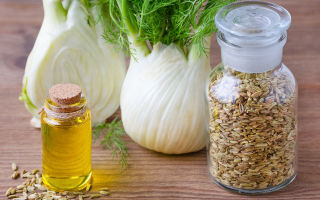Content
- 1 What is fennel and what does it look like
- 2 Where and how does fennel grow
- 3 Fennel chemical composition and nutritional value
- 4 What helps the healing properties of fennel
- 5 How is fennel taken?
- 6 How to brew fennel fruit
- 7 The use of fennel in traditional medicine
- 8 The use of fennel in cooking
- 9 Fennel in cosmetology
- 10 Contraindications and side effects for the human body
- 11 How to choose and store
- 12 Conclusion
- 13 Reviews on the use of fennel for newborns and lactation
Among the medicinal herbs, fennel is distinguished separately. The plant stimulates the production of breast milk during lactation and helps relieve colic in babies. However, the beneficial properties and uses of fennel are not limited to these indications. It is used as part of folk remedies for the treatment and prevention of diseases of various body systems.
What is fennel and what does it look like
The plant is a perennial and belongs to the Umbrella family. There are 2 known types of fennel:
- Pharmacy. The herb is intended for the prevention and treatment of various diseases.
- Vegetable (Florentine, Sicilian, Cantino, Romanesco, Rudy). Its use is advisable to add a special flavor to dishes.
The stem can grow up to 2 m in height. It has a branched structure and is distinguished by a light blue bloom on the surface. The root is characterized by a bulbous shape. The dissected leaves can be either small or medium. Small yellow flowers resemble umbrellas.
The fruits are small berries that are brown and oblong in shape. They taste sweet.
The seeds that make up various products resemble dill. They are often used as a condiment. The seeds are gray-brown in color with a greenish tint. The aroma is similar to anise. It has cucumber freshness and tart bitterness.
Where and how does fennel grow
The herb can be found in the southern regions of mainly Central Asia. The plant is also common in the Caucasus, Krasnodar Territory and Crimea.
Fennel chemical composition and nutritional value
The healing plant is distinguished by the presence of nutrients in significant concentrations. The composition includes:
- quercetins;
- antioxidants;
- flavones;
- rutin;
- flavonoids;
- ascorbic acid;
- vitamins belonging to group B;
- tocopherol;
- essential oils;
- alimentary fiber.
The food can be eaten dry and fresh:
- greens;
- roots;
- seeds.
Roots, leaves and seeds are rich in:
- B vitamins, ascorbic acid and retinol;
- sodium, phosphorus, magnesium, iron, calcium, selenium and other minerals.
Energy value is 30 kcal (100 g). Among the nutrients are called:
- fats (0.2 g);
- carbohydrates (7.4 g);
- proteins (1.24 g).
For medical purposes, fennel fruits are also used in the composition of medicines, which contain:
- oleic and petroselinic acids;
- essential oils;
- proteins;
- antennae.
What helps the healing properties of fennel
The use of rhizomes contributes to:
- restoration of vision and elimination of tired eyes syndrome;
- elimination of toxins and decay products;
- ARVI treatment;
- normalization of the digestive organs (facilitating the digestion of food, eliminating bloating, gas formation, colic);
- prevention of the development of malignant tumors;
- slowing down the aging process of the body;
- beneficial effects on blood vessels, heart;
- prevention of depressive conditions;
- increasing the body's defenses.
Fennel leaves (fresh or dried) are added to salads and soups to:
- toning the body;
- stimulation of sexual desire;
- normalization of digestion (with bloating and flatulence).
Seed products are used in the following cases:
- children's colic;
- cardiovascular diseases;
- stomach pain;
- cough and SARS;
- high cholesterol.
Fennel fruit has an expectorant, analgesic and disinfectant effect. The oil contributes to:
- increased appetite;
- stimulation of lactation;
- elimination of bad breath;
- cleansing and regenerating the liver;
- elimination of pain syndrome;
- detoxification of the body;
- increased gastrointestinal secretion.
Fennel oil has diuretic properties. The product has a calming effect.
Why fennel is good for women
The root of the plant allows you to normalize hormonal levels. Fennel-based remedies are used for irregular cycles and severe pain during critical days. Fennel oil, photo of which is located below, relieves symptoms typical of menopause.

The healing properties of fennel for men
The plant restores potency due to its beneficial effects on the prostate gland and hormones. To normalize the work of the reproductive system, it is advisable to use the funds in the form of tinctures.
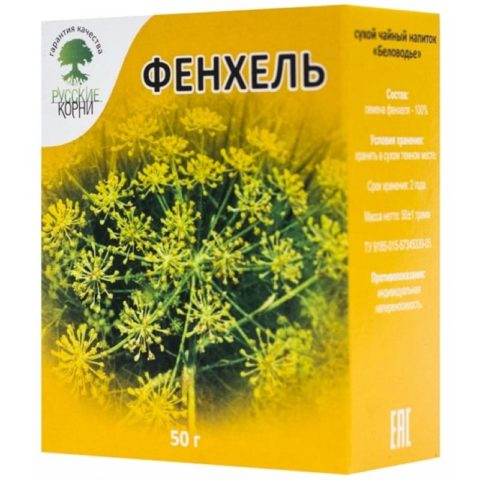
What Fennel Treats in Babies and Children
The spice eliminates flatulence and colic. The herb is the main ingredient in colic remedies for babies.
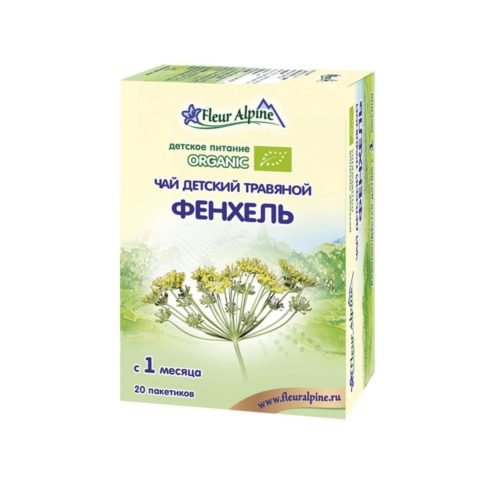
How is fennel taken?
There are various ways to use the herb. It depends on the specific indication for use.
Tea
The drink is prepared in the same way as the broth. The difference lies only in the duration of the infusion of funds.
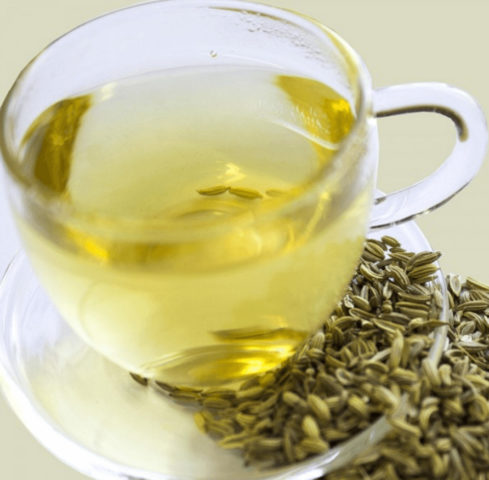
Decoction
A tablespoon of seeds, crushed leaves or roots is poured with 250 ml of boiling water and insisted for 1 hour. Gargle with a remedy.
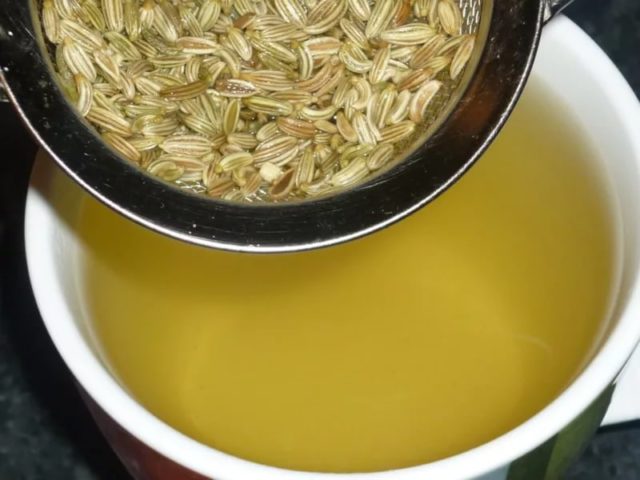
Tincture
To prepare the product, the crushed raw materials are insisted on alcohol, vodka or white wine. The exposure time is 1 month.
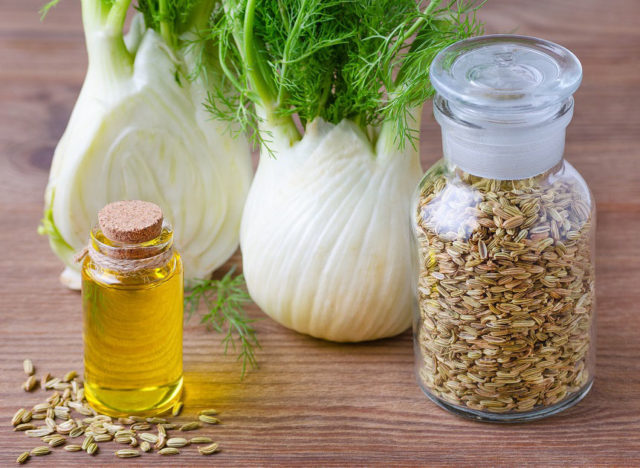
Oil
The solution is included in massage products. It is enriched with gels, creams and shampoos. During colds, oil is used in special aroma lamps.

How to brew fennel fruit
The plant is used in the form of tea, decoction and infusion. Preparing a fresh drink daily is recommended.
How to brew fennel for newborns
To prepare a product intended for children, you need to crush several grams of seeds with a mortar and pour boiling water (200 ml). The drink should be infused for 30 minutes.
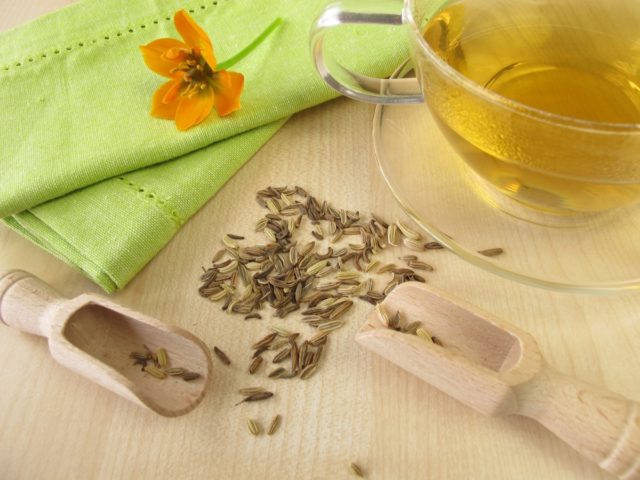
The use of fennel in traditional medicine
The root and other parts of the plant are used to treat and prevent various pathologies. This is due to the healing properties of fennel.
With amenorrhea
In the absence of menstruation, special herbal preparations can be used to help restore the cycle. A small amount is mixed in a container:
- rhizomes of parsley;
- fennel seeds;
- wormwood;
- juniper and rose hips;
- Potentilla;
- rue.
The mixture (20 g) is poured over with warm water (300 ml). Filter the infusion before use.
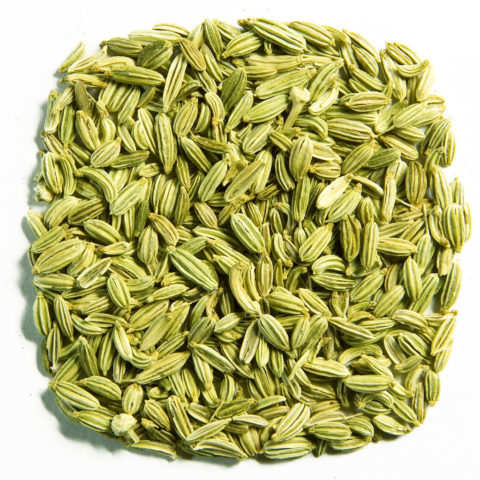
For constipation
As a laxative, fennel is widely distributed in Asia. Dissolve 10 drops of oil in 1 liter of boiled water. Drink from fennel for intestines is drunk for several days in 2 tablespoons.
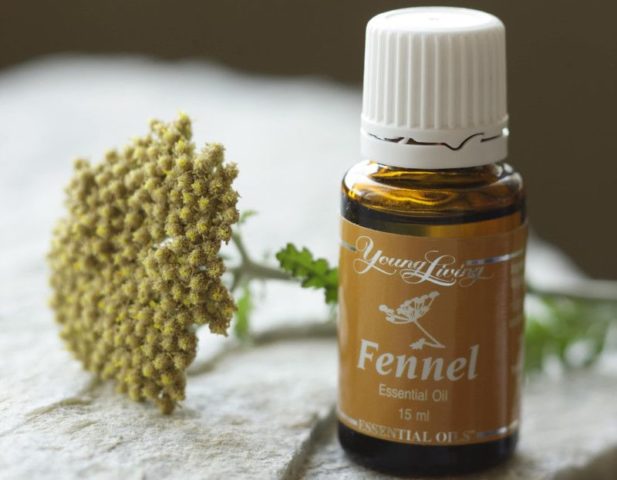
How to take fennel for flatulence
To reduce the amount of gas in the intestines, you can use seeds, fruits or flowers to prepare the product. Raw materials are poured with boiling water (250 ml) and insisted until cooled.

How to drink fennel for a cough
For ARVI and bronchitis, oil and crushed raw materials are used. To prepare the product, you need to pour water (200 ml) on the ground fruits, sheets (10 g). The broth is simmered in a water bath for 20 minutes and insisted for half an hour. After straining, the drink is taken 4 times a day, 100 ml.
Fennel is also suitable for steam inhalation. Boil about 2 liters of water in a saucepan, add 4 tablespoons of herbs and cook for 7 minutes. Then you should cover your head with a towel and inhale the steam for 10 minutes. To enhance the effect, you can add an oil solution of fennel. The product is also suitable for baths and for use in aroma lamps.
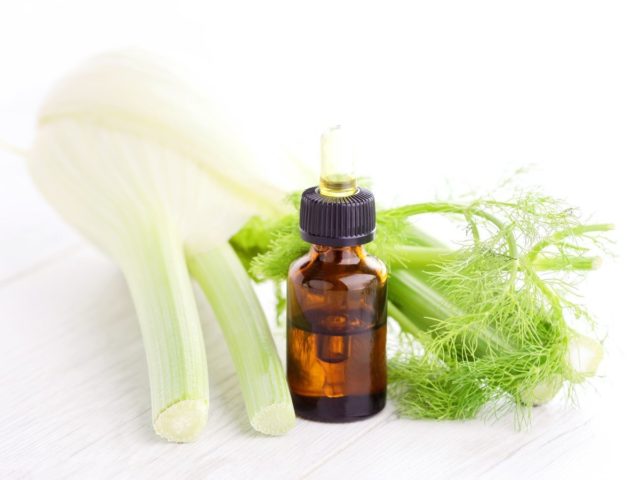
How to drink fennel for weight loss
The medicinal properties of the plant allow it to be used to normalize weight. Fennel is included in the diet in the absence of contraindications. The effect is due to the B vitamins that make up the composition, which help accelerate metabolism. The presence of flavonoids and glycosides helps remove toxins from the body.
In order to lose weight, it is necessary to use the seeds of a medicinal plant. They reduce the cravings for sweets. Fennel seeds are chewed for a few minutes to satisfy hunger. Due to the diuretic effect, excess fluid and salts are removed. The seed can also be brewed. To prepare the broth, 1 spoonful of raw materials must be poured with water (250 ml) and brought to a boil in a steam bath. The tool can be drunk four times a day, 50 ml.
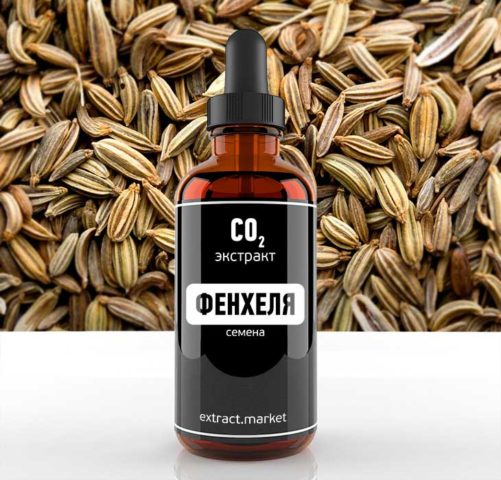
Using fennel to enlarge the bust
The spice is prized in folk medicine. A plant called fennel can help enlarge the mammary glands. This is due to the presence of phytoestrogens, which activate the production of female sex hormones.
To achieve the desired effect, you need to drink tea with medicinal herbs before or after meals for two or more months. A pinch of cardamom, 3 drops of fennel essential oil, a teaspoon of sugar are poured with boiling water (200 ml). The tool is used three times a day.
The use of fennel in cooking
The seasoning is widely used in the preparation of various dishes:
- salads;
- marinades;
- refueling;
- soups;
- meat and fish;
- cool drinks.
Adding spices to baked goods and jams improves their taste. Fennel goes well with dried fruits, jam. The inflorescences can be used for conservation.
Fennel in cosmetology
The oil is added to creams and masks, which allows:
- eliminate puffiness;
- increase facial turgor;
- increase collagen production;
- tone and moisturize the skin;
- get rid of fine wrinkles;
- slow down photoaging;
- relieve inflammation.
The herb-based product can be used on any type of skin:
- Dry... Using fennel helps soften the epidermis.
- Fatty... Oil drops help unclog pores.
Fennel oil is effective for aging skin. To prepare the mask, you need to mix a teaspoon of honey with the yolk, and then add turmeric (0.5 teaspoon) and 4 drops of the solution. The product is applied for 20 minutes.
The oil composition can be used to eliminate dandruff, strengthen hair and hair growth. To prepare the mask, you need to combine 1 beaten egg, honey (1 teaspoon), aloe juice (1 tablespoon) and ether (7-8 drops). The composition should be applied to the roots and washed off after 1 hour.
The product is recommended to enrich shampoos and hair balms. A good result can be expected from aroma combing. A few drops of oil are applied to a natural brush or comb. The hair is combed in different directions.
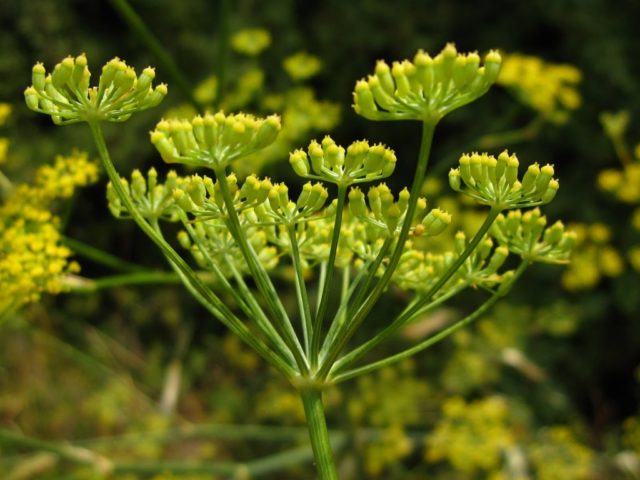
Contraindications and side effects for the human body
The plant has a beneficial effect on the body. However, fennel can have both health benefits and harm.
The herb is rich in biologically active substances of natural origin. Its use is contraindicated in the following cases:
- pregnancy;
- hyperlactation;
- convulsive syndrome;
- diseases of the digestive system, which are accompanied by diarrhea;
- hypersensitivity reactions;
- severe rhythm disturbances.
How to choose and store
The plant is used as a therapeutic and prophylactic agent. In the case of self-harvesting of fennel, the stem must be cut off from the ground by 30 cm. After drying, the storage period can reach 3 years, provided the necessary conditions are met.
When buying stems, you need to pay attention to their color. They should have a rich green tint. Do not purchase withering fennel stems.
The roots are normally light green in color and have a pleasant smell. Cracks indicate poor product quality.
Conclusion
The beneficial properties and uses of fennel are known in modern medicine. All parts of the plant are used for prophylactic and therapeutic purposes. The advantage of the remedy lies in the absence of pronounced contraindications and the possibility of using it during lactation, in early childhood.
Reviews on the use of fennel for newborns and lactation
According to the instructions for use, the herb can be used to increase the production of breast milk. The plant is part of children's teas and decoctions for colic in babies. Reviews contain information about the results of using fennel.

